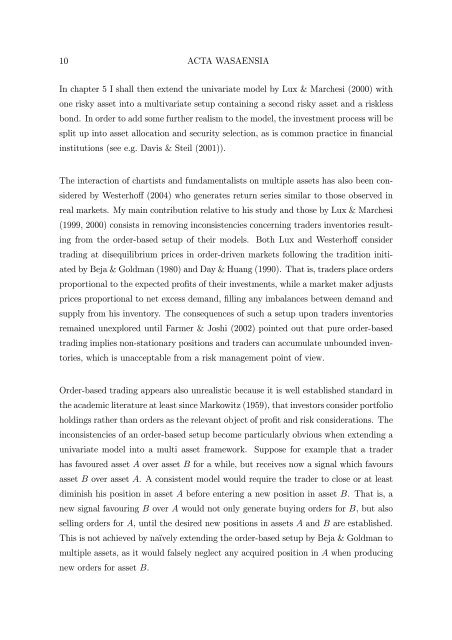BERND PAPE Asset Allocation, Multivariate Position Based Trading ...
BERND PAPE Asset Allocation, Multivariate Position Based Trading ...
BERND PAPE Asset Allocation, Multivariate Position Based Trading ...
Create successful ePaper yourself
Turn your PDF publications into a flip-book with our unique Google optimized e-Paper software.
10 ACTA WASAENSIAIn chapter 5 I shall then extend the univariate model by Lux & Marchesi (2000) withoneriskyassetintoamultivariatesetupcontainingasecondriskyassetandarisklessbond. In order to add some further realism to the model, the investment process will besplit up into asset allocation and security selection, as is common practice in financialinstitutions (see e.g. Davis & Steil (2001)).The interaction of chartists and fundamentalists on multiple assets has also been consideredby Westerhoff (2004) who generates return series similar to those observed inreal markets. My main contribution relative to his study and those by Lux & Marchesi(1999, 2000) consists in removing inconsistencies concerning traders inventories resultingfrom the order-based setup of their models. Both Lux and Westerhoff considertrading at disequilibrium prices in order-driven markets following the tradition initiatedby Beja & Goldman (1980) and Day & Huang (1990). That is, traders place ordersproportional to the expected profits of their investments, while a market maker adjustsprices proportional to net excess demand, filling any imbalances between demand andsupply from his inventory. The consequences of such a setup upon traders inventoriesremained unexplored until Farmer & Joshi (2002) pointed out that pure order-basedtrading implies non-stationary positions and traders can accumulate unbounded inventories,which is unacceptable from a risk management point of view.Order-based trading appears also unrealistic because it is well established standard inthe academic literature at least since Markowitz (1959), that investors consider portfolioholdings rather than orders as the relevant object of profit and risk considerations. Theinconsistencies of an order-based setup become particularly obvious when extending aunivariate model into a multi asset framework. Suppose for example that a traderhas favoured asset A over asset B for a while, but receives now a signal which favoursasset B over asset A. A consistent model would require the trader to close or at leastdiminish his position in asset A before entering a new position in asset B. Thatis,anewsignalfavouringB over A would not only generate buying orders for B, but alsoselling orders for A, until the desired new positions in assets A and B are established.This is not achieved by naïvely extending the order-based setup by Beja & Goldman tomultiple assets, as it would falsely neglect any acquired position in A when producingnew orders for asset B.
















